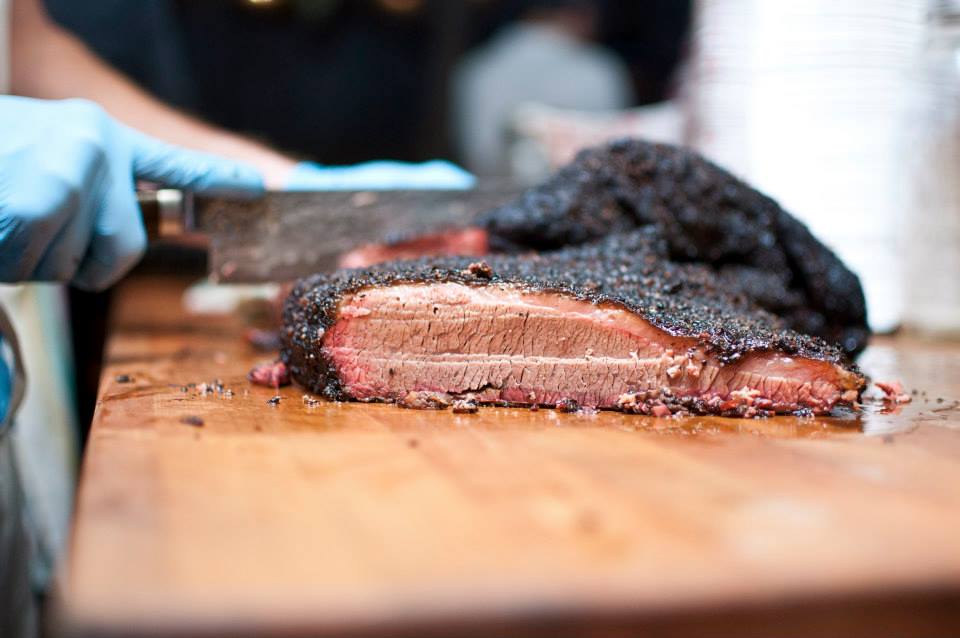
Morgan’s Barbecue restaurant in Brooklyn has many vegetarian options. Matt Fisher’s place sells brisket ravioli. Hometown Bar-B-Que makes Caribbean jerk chicken. Beast of Bourbon in Bed-Stuy pairs its smoked meat with remoulade.
Welcome to a new chapter in Brooklyn barbecue, one that’s blending multicultural cuisines and artisanal flavors with one of America’s most classic foods. This isn’t your traditional Southern barbecue, nor is it intended to be.
Six barbecue restaurants have opened in Brooklyn since June 2013. Three others opened in 2012. Two prominent ones are slated to open soon. Pitmasters say the borough’s ‘cue scene is far from saturated. There’s plenty more meat to come.
One Brooklyn pitmaster, Daniel Delaney, received a James Beard Award nomination earlier this year — an honor bestowed on the best of the culinary world. Delaney’sBriskettown in Williamsburg makes a wedge salad that includes pickled shallots and toasted almonds.
Mighty Quinn’s — the No. 1 Zagat-rated new restaurant in New York of 2013 — is opening up its Crown Heights location on August 28th. Pitmaster Tyson Ho is opening Arrogant Swine, whole-hog, North Carolina-style barbecue establishment in Bushwick later this summer, too.
“New York and Brooklyn — that’s the stage right now for barbecue,” said John Avila, a Texas native and former pitmaster atMorgan’s, which opened a year ago in Prospect Heights (Avila left Morgan’s in the spring to open a restaurant in Houston).
Brooklyn’s pitmasters say that the borough is the prime location for innovative barbecue because they have a relatively clean slate — free of old practices — to experiment and try new things while not disrespecting their neighbor. These pitmasters are also taking a little bit of other cultures — e.g. brisket ravioli — and combining it with barbecue. That combination of cuisines is largely unseen in other barbecue regions of the country.
“That’s where it lets guys like Matt [Fisher, pitmaster atFletcher’s BBQ] and I shine cause Matt and I completely turn it upside down on its head,” says Bill Durney of Hometown Bar-B-Que, who cooked at a James Beard Foundation event in February. “I think Brooklyn’s [barbecue] identity is that we are not ball-and-chained to our traditions.”
Although many restaurateurs cited Brooklyn’s eclectic food scene as a reason to come, they also said the ventilation costs for barbeque smokers make Brooklyn more affordable. Owners have to pay ventilation costs per floor in the building they occupy. It can cost as much as $10,000 per floor to build a regulation-approved smoker. With Brooklyn’s low-rise buildings, it’s more affordable for smoking meat.
“As it became harder and harder to build true barbeque places in Manhattan, everybody was moving out to Brooklyn,” says Frank Davis, a longtime pitmaster in Brooklyn and the current chef at Williamsburg’sNorthern Bell, which offers some smoked meats on its southern cuisine menu.
Pitmasters say barbeque, especially smoked meat, fits into the borough’s growing health foods culture because of its quality. Many boasted about their raw product — hormone-free, antibiotic-free meat. The farmers’ market lovers, organic eaters, gluten-free dieters and even vegetarians come to try some portion of the menu, they say.
“I’ve done so much research and learned so much more about using anti-biotic free, hormone-free,” says Durney of Hometown. “So 90 percent of the food we make here is what I would consider that really high-end, organic cut of meat.”
Many new places are within walking distance of each other, and are easily accessible on subways. But Durney’s Hometown is an away game. Located one block from New York Harbor in Red Hook, Hometown is a mile and a half from the nearest subway station. Its isolated location, compared to others, became apparent before it opened.
Hurricane Sandy dumped six feet of water throughout Durney’s 4,500 sq. ft. facility only a few months before he planned to open.
Because Hometown was not an established business yet, it received no federal, state or city aid. For two weeks after the hurricane, Durney stood outside his building with his smoker — the only thing to survive Sandy — and cooked 3,000 pounds of meat for the Red Hook community, donated from a variety of suppliers.
Faced with renovation costs and finding funds — Durney would not say how much — the Brooklyn native never considered opening Hometown, which opened last August, anywhere besides Red Hook.
“This is the absolute greatest community on the planet. Every single person in this community is a family member,” Durney says. Sandy, “made it crystal clear that I would never open anywhere else.”
Click here to see our map of where to eat barbecue in Brooklyn.



